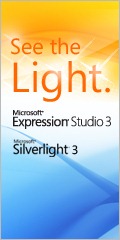Silverlight 3 Released!
Silverlight 3 is officially released into production today!
Silverlight has come a long way in the short time since its V1 launch in September 2007 and V2 release in October 2008. Each version brought very significant enhancements to the platform. My earlier post on the Silverlight 3 Beta has details on new features, adoption statistics to date, and a small list of interesting Silverlight applications.
To summarize though, some significant changes in this release are:
Out-of-Browser
Silverlight 3 offers a new set of features for building safe, secure, sandboxed companion experiences for the Web through a single coherent platform, that run on user desktops. Out-of-browser support allows Silverlight applications to run on Windows or Mac desktops and deliver online, offline, or intermittently connected access to applications and content—without having to rebuild applications on another platform. Silverlight application can be easily found on the desktop or start menu, and launched with a single click—eliminating the requirement for privileges to run. In addition, it can test if the network is connected, update itself with newer versions, and have access to isolated storage.
This works very similar to Adobe AIR, but Silverlight does not need a separate platform/runtime download in order to install applications and run them. If an application is enabled to run from the desktop, all a user has to do is right-mouse click on the application directly on the web page, which will have an option to “Install to Desktop”.
Smooth Streaming
Smooth Streaming technology is the union of online player experiences delivered through Silverlight and the streaming capabilities provided through Windows Server + IIS, that enables adaptive streaming of media so users with high bandwidth connections can experience HD-quality streaming while others with lower bandwidth receive the appropriate stream for their connectivity.
This is the technology first used for the 2008 Beijing Olympics event by NBC to deliver live and on-demand programs over the Internet, then used at many other places such as Netflix, NCAA March Madness 2009 for CBS, the 2009 Presidential Inauguration, and most recently for the Michael Jackson’s memorial service.
What’s significant about Smooth Streaming is that to deliver long-form content, along with all types of advertising scenarios (pre/post-roll, interstitial, overlay, etc.), can be delivered from Microsoft’s Internet Information Server (IIS) over the ubiquitous HTTP protocol, without requiring use of traditional streaming servers. Short-form content can still leverage out-of-the-box progressive download feature as well. Furthermore, this means it is much simpler to scale out the back-end infrastructure to serve the content to any amount of online audience, as an operation can add IIS servers quickly, plus leveraging web caches from CDN’s to further improve the scale and reach of any content.
Prototyping with SketchFlow
SketchFlow, the dynamic prototyping feature in Expression Blend 3, demonstrates the flow, layout, and transitions of an application through interactive “sketches” to convey initial concepts. And concurrent workflows between design, user experience, and development ensure that the visuals, interaction model, and the underlying architecture of an application can be simultaneously evolved and delivered as a completed project.
SketchFlow ehances the speed and efficiency to prototype a vision for an application. Rapidly demonstrate and iterate on ideas, application flows, screen layout, and functionality of an application using a SketchFlow prototype.
Lastly, visit these resources for more information:
As well as a few of the projects my team and I worked on this year:
- Kelley Blue Book Perfect Car Finder
- Photobucket Visual Search
- Stargate Universe Photosynth
- NewEgg.com Digital Camera Promotions
- Grubb & Ellis Spotlight
- LA Fitness Find a Club and Club Tour
- InXile Line Rider
